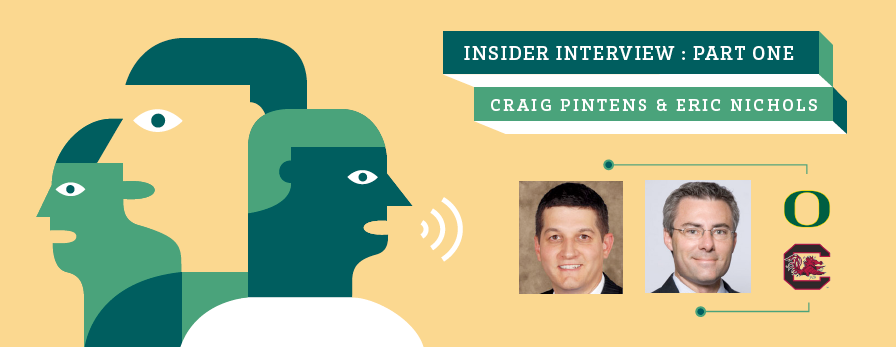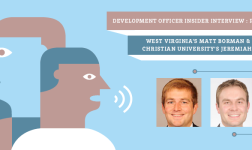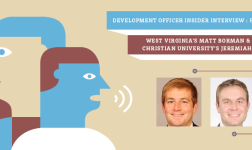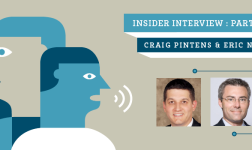
Our first insiders are Craig Pintens—Senior Associate Athletic Director for Marketing & Public Relations at the University of Oregon—and Eric Nichols, Assistant AD and Director of Marketing for the University of South Carolina. Craig is the president of NACMA—the National Association of Collegiate Marketing Administrators—and Eric is the first Vice President.
Both Craig and Eric have overseen major national marketing campaigns and are considered to be two of the most innovative strategists in college marketing. Both were good enough to sit down with Ryan Matthews, Winthrop’s Managing Editor, to discuss current trends in fan engagement, growing revenues, and increasing attendance.
Winthrop intelligence is pleased to present our first Insider Interview, letting key leaders in college sports go deeper by passing off the mic, for one-on-one expert interviews.
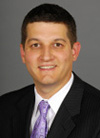 Craig Pintens – University of Oregon
Craig Pintens – University of Oregon
Senior Associate Athletic Director/Marketing & Public Relations
 Eric Nichols – University of South Carolina
Eric Nichols – University of South Carolina
Associate AD/CMO
Listen to the podcast:
ERIC NICHOLS – Craig what’s working at Oregon? What’s driving revenue, attendance, fan engagement? You guys had a new basketball facility open recently and of course the football program has planted you firmly at the top of the college football scene. Baseball is also an up and coming sport for you guys.
CRAIG PINTENS – As far as driving revenue, fan engagement, and attendance, I think everyone is dealing with this nationwide in college athletics. Chief Marketing Officer Round Table: Best Practices, Trends & TechnologyIn the fast-paced world of college athletics marketing—where the sophistication of promotion is continually increasing, evolving, and growing more refined—chief marketing officers…read more.You’re hearing it more and more, the buzzword “fan experience.” No longer are we competing against other schools, you’re competing against the television. The fact that for us in the Pac 12, our games in basketball are all on TV. So now you’re competing against a 55” TV, a very comfortable chair, a bathroom facility that is usually open (depending on who else you have in your family), great parking, as many beverages as you can stock. So that’s what you’re competing against.
For us, we’re trying to find ways to enhance the experience in the stadium. Because, at the end of the day, for a big time event, there’s nothing that compares to being there live. We have to find a way to create those events on a regular basis.
What are you doing to drive those same things? We’ve talked on the phone a lot about basketball; I think that’s an issue for a lot of schools.
ERIC NICHOLS – One common refrain is about how to bring television into the stadium. I’m not sure that’s the right thing. There is a certain level that is just necessary—we’re talking about wifi, we’re talking about amenities. You need to be able to send a text, take a photo, and share it with your friends and family. I want that as a marketer. We want people to see you having fun at the game. But to carry it all the way to replicating broadcast?
I want it to be a different experience. If we’re trying to create the same experience, it’s just much better in your recliner. But then again, these aren’t logical decisions people are making—no logical person would sit out on a 102 degree day, sun shining in their face, to watch you play a team that you’re paying 900k to beat. That just doesn’t make any sense. Fans are making those decisions beyond the experience.
Last year in football we had two new amenities. We’re probably one of the only schools in the country able to introduce two major amenities in the same year. We have pre-game football tailgating facility, with band parades and team walks and all the pomp and circumstance. But we also have a brand new video board. So in one year we’ve drastically changed the fan experience and it helped, it certainly did, but we didn’t exactly see people pouring in from one year to the next.
As far as what is actually making a difference—not in terms of fan engagement—but in driving attendance, driving revenue, it’s the same thing it has been for the last few years and that is outbound sales. We finally have an outbound sales-force, outsourced, but it’s IMG Learfield ticket solutions. They’re performing like gangbusters and we really expect them to make a huge impact on basketball in the upcoming year.
CRAIG PINTENS – You guys just added that this year, is that correct, in the spring?
ERIC NICHOLS – We’ve had summer sales academies, I had those dating back to when I was at Vanderbilt. And we’ve had success there. It’s also from that data that we were able to get approved and pursue this initiative.
You folks do things a little bit differently at Oregon, is that right?
CRAIG PINTENS – Yeah, we launched our outbound sales team, late in the fall last year so not really an impact on football, but it made little bit of an impact on basketball. We’re pretty excited about it this summer—they’re doing a great job with football season tickets and as they get into basketball ticket season, sales are going to be great.
We chose to do a very unique set up. It’s an outbound ticket solution. It’s called Duck Ticks, it’s a separate LLC that we set up. So essentially we work with them, just like we would an outbound ticket sales company, but they are independent and the margins are a little bit different than some other places. So if you’re able to do that, obviously it’s great because you keep more of the revenue. If people aren’t doing outbound ticket sales, not only are they ten years behind, they need to really investigate themselves a little bit.
ERIC NICHOLS – Exactly, but, as you know—you’ve been on four different campuses—that’s a tough sell internally in academia. I think all of us would like to not outsource our operations. But it makes it easier. It’s what you can get pushed across on campus.
And if you are a significant institution, you’re not able to pay commission. Outbound ticket sales is definitely something that people need to examine and it’s a long process, something that we’ve worked on here for a long time. I think that’s true of every campus that has tried to do something similar.
CRAIG PINTENS – Let me jump into a different area, I know this is something that you’ve done really well at South Carolina. How do you gather data on fans, their preferences, and how do you get them to come to your games?
How do you learn about fan behavior in different communities of fans? For example families or tailgaters.
ERIC NICHOLS – Well, I appreciate you saying that, I don’t know if we’re exactly where we want to be, but there are some basic things that are just a part of my basic DNA. We do surveys like we brush our teeth in the morning, and we hold onto that data. Every sport, every season we’ll do a post season survey and we’ll have some common questions that become important when you look for trends.
For example we have trends in football that trend positive, and you might argue that that’s because we’re having success. But we have a couple of areas where the trend is negative or going backwards. So we’ll call the individual unit in and address the issue. So having data like that and having objective information to make some decisions is huge for us.
We also did a brand research study a couple of months ago that we just got back. Your brand isn’t what you say it is, it’s what your constituents say it is. We wanted to be sure we’re articulating what our brand is. We can’t do that ourselves. We used a firm—it was our Moore School of Business, the number one international business school in the country. They came with tons of credentials. They didn’t tell us a lot of things new, but reaffirmed much of our thinking. It’s allowed us to be more confident and to take a stronger direction on some of our messaging.
The current project I’m working on is a data warehouse. We need to find a solution. We have all this data that lives all over, but doesn’t communicate. We’re lucky that Ticketmaster is our client for both ticketing and fund raising. So having those two units talk to each other is huge. But email, merchandise, these surveys, we don’t have a good place for all that data to live and that’s what we’re currently researching. We want to take advantage of all that data.
CRAIG PINTENS – Are you working with campus on that at all? To integrate some of their databases?
ERIC NICHOLS – Absolutely. The alumni association, campus resources, and campus relations, have shown an interest in how we can create one common, mega-warehouse where we can all have access to it.
CRAIG PINTENS – If you ever figure that out, you will win the Nobel Peace Prize. That has been a common issue on every campus I’ve ever been on. There are so many different systems, whether it’s in your alumni relations center, or the foundation, or any type of fundraising, or admissions, or ticketing and athletics.
ERIC NICHOLS – And beyond the functional, technical issues, there’s the philosophical. People aren’t real delighted to hand over their data very frequently. However, I don’t know if Oregon is the same as the state of South Carolina, but the downturn in the economy hit us very, very hard. Our university has had their funds cut significantly, so they’re looking for new ways to create partnerships. And sometimes those partnerships are within their own family. So the doors are a little bit more open than they used to be.

